The largest surface warships in the American inventory are the three destroyers of the Zumwalt class. These ships are undoubtedly among the most futuristic-looking on the seas, but many have questioned their utility, thanks to the program's troubled history, and the fact that the mission they were built for stopped making sense a decade or so ago.
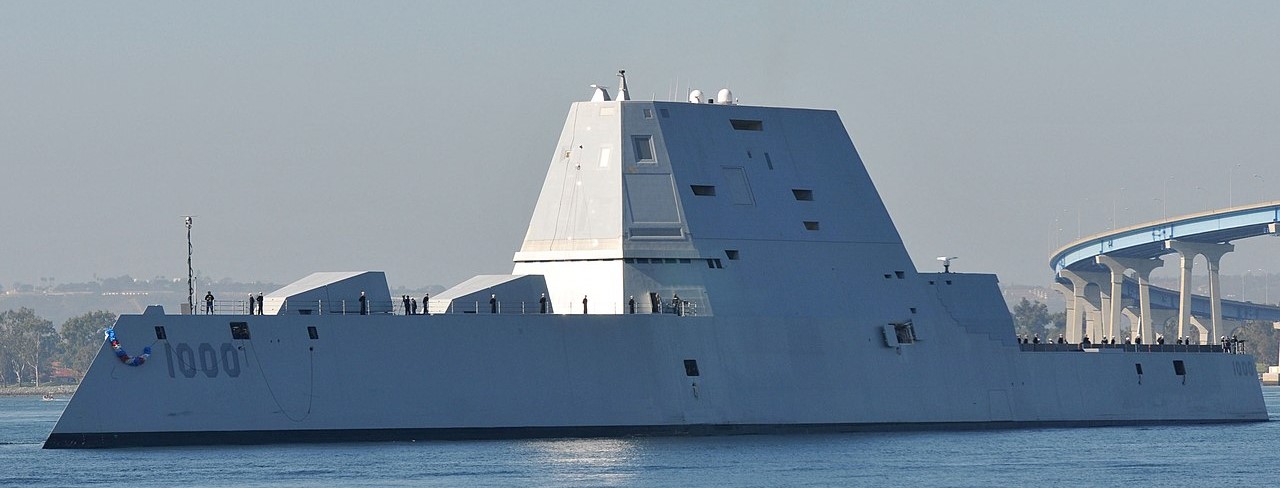
USS Zumwalt
The Zumwalts, much like the Littoral Combat Ship, dates back to the 1990s, when the US Navy was attempting to define itself in the post-Cold War world. The mission it had built itself around for the previous 40 years, facing down the Soviets at sea, was gone, and it turned instead to the job of influencing events on land. A cheap ship optimized for land attack seemed like a good complement to the multi-role Burkes and Ticonderogas, particularly as it could be fitted with a new gun that would give at least a partial replacement for the capabilities of the recently-retired battleships.
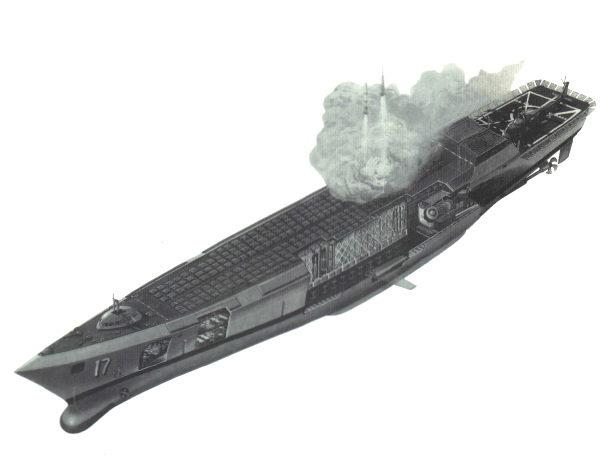
The Arsenal Ship
The Navy's next surface combatant was first studied as part of the SC-211 program, which looked at an extremely wide range of ships for future missions, trying to find ways to cover the Navy's responsibilities at a reasonable cost. One early proposal was the Arsenal Ship, a vessel that would be fitted with about five hundred VLS cells for Tomahawk and a very minimal combat system to keep costs low. This single-purpose design was not popular with most in the USN, who recognized that such designs are usually not a good idea. However, it gained popularity with many outside the navy, as well as the CNO, Jeremy Boorda, and so development began. Many of the concepts showed the number 72, which would be the next number in the battleship series after Louisiana of the Montana class. However, Boorda came under fire for improperly wearing some medals and ultimately committed suicide, and the idea was scrapped.
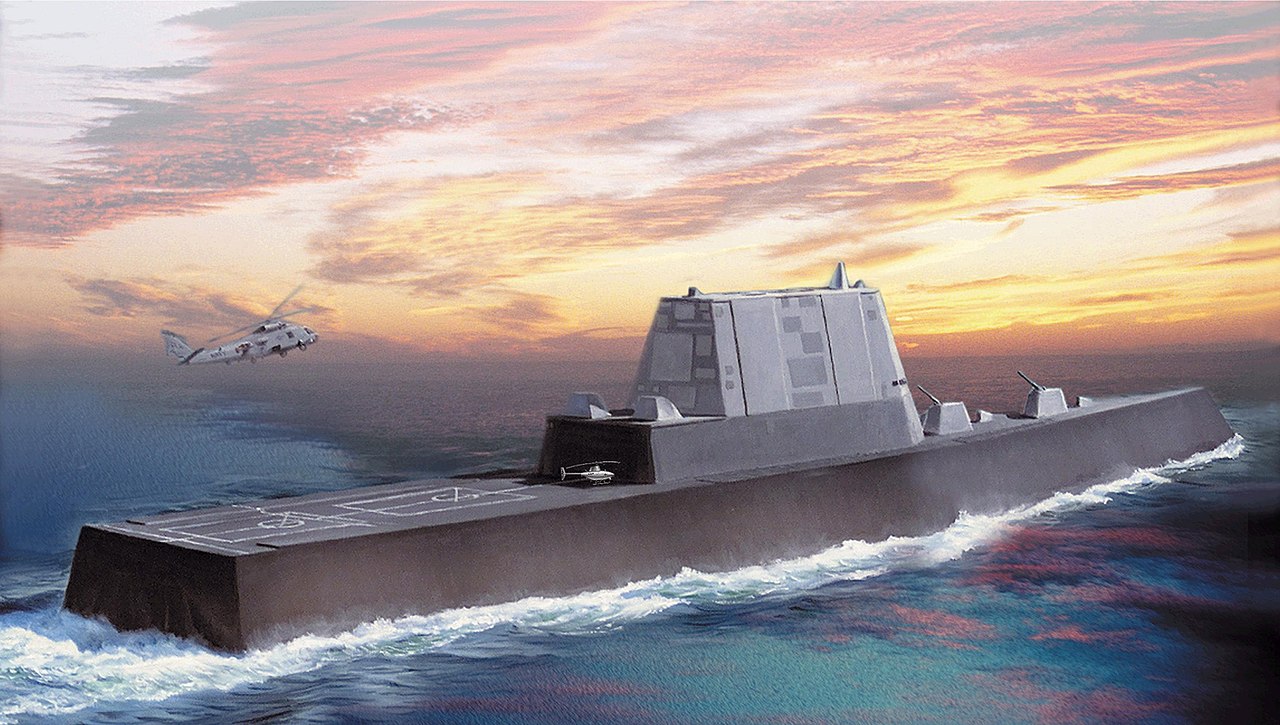
An early artist conception of what became Zumwalt
But while the designs that followed the Arsenal Ship were more conventional in concept, with proper combat systems that gave some capability against air and subsurface targets as well as lots of missiles for land attack, they were still to be the most technologically radical warships in decades. Some of these innovations were reasonably sensible, such as integrated electric propulsion. Others, such as an attempt to cut crew by two-thirds or more relative to a Burke, had the potential to work out well, but also would stress the crews quite badly. But the new ship's party piece would be an unprecedented degree of radar stealth. This was in keeping with the zeitgeist of the 90s, and in theory would allow the ship to operate independently despite lacking Aegis. However, keeping radar cross section down at sea proved to be extremely difficult, and the compromises required to achieve the desired degree of stealth would cost the project dearly.
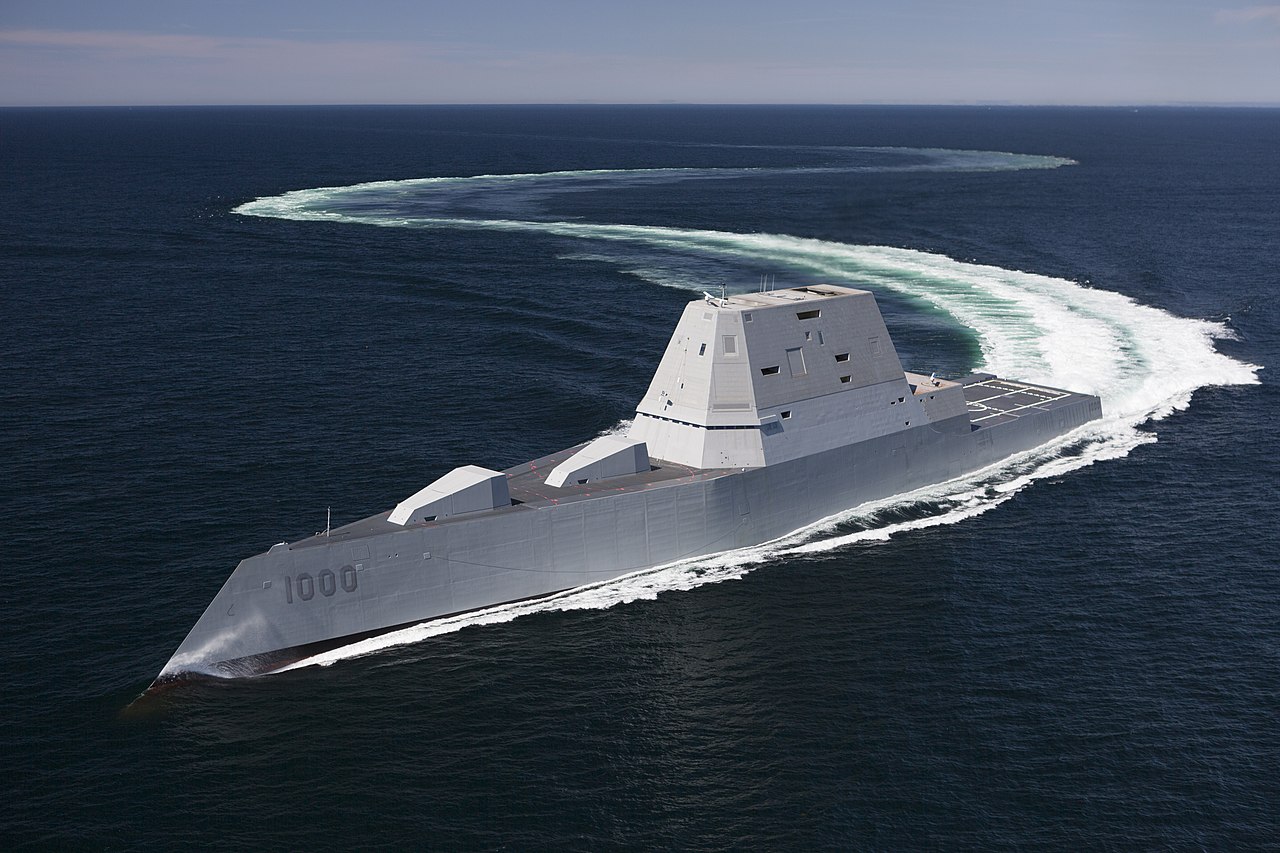
Radar stealth at sea poses two basic problems, both of which stem from the fact that stealth only works if the shape of the stealthy object is precisely controlled. The first, in common with stealth aircraft, is that the shape must be tightly controlled. This meant no equipment on deck, and a generally much larger hull thanks to the need to wrap the same systems in a stealthy shape. This was generally less of a problem for aircraft, as they had already needed to be streamlined, as opposed to the generally utilitarian upperworks of most warships. The second issue, unique to ships, was that reflections could come not only from the ship itself but also from interactions with the sea. This was the logic behind the unique inward-sloping form chosen for the new ship, whose nearest cousin was used on French pre-dreadnoughts. However, ships move relative to the sea, and to maintain the required shape, the stealth ship would need to be stabilized and fitted with a ballast system to make sure its draft, and thus its shape, didn't change as fuel burned or weapons were fired. Its bow would also need to be designed to pierce through the waves instead of riding up over them as most ships do, which made it difficult or impossible to put people on deck forward.

The testbed for the Advanced Gun System
The ship as designed in the late 90s would have used a unique wave-piercing tumblehome hull with phased-array radars integrated into the deckhouse. Armament was planned to be as much as 256 VLS cells and two new 155mm vertical guns2 firing guided projectiles for cheap fire support. Total displacement would have been somewhere between 16,000 and 18,000 tons, bigger than any American surface combatant since the nuclear cruiser Long Beach. And all of this was to be combined with a unit cost for the fifth unit of no more than $750 million. That figure was looking less and less feasible, and the design was trimmed down somewhat in 2000, with the vertical guns replaced by a more conventional turreted 155 mm Advanced Gun System (AGC) and the VLS cut to 80 cells.
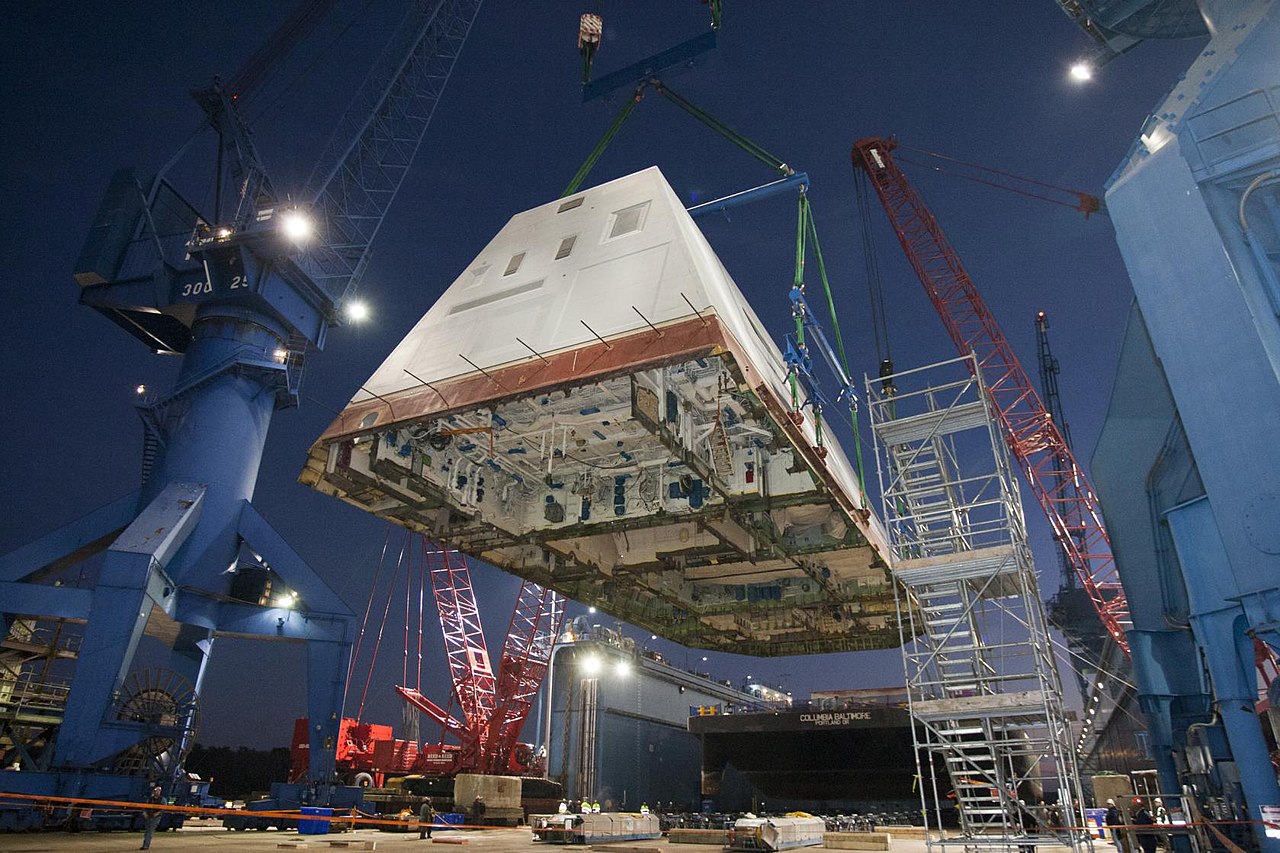
Zumwalt's composite deckhouse is lowered into place
But even this wasn't enough to save the original 32-ship program, intended to replace the Spruance and Oliver Hazard Perry classes. The 5th ship remained above $1 billion, and the buy was to be cut to only 24. Throughout the 2000s, the number to be procured continued to fall, going to the single digits in the middle of the decade, and finally being capped at 3 in 2008. This drove up unit cost massively, particularly as the R&D costs now were spread across far fewer units than originally planned. The program, named after former CNO Elmo Zumwalt, was now in breach of the Nunn-McCurdy Amendment, designed to control growth in procurement costs. For some reason, Congress passed up the chance to cancel the whole program, and instead settled for deleting the L-band radar that was to be integrated with the shorter-range X-band radar retained on the ship. A cynic would suggest that this was at the behest of the Maine congressional delegation, as all three ships were to be built by Bath Iron Works although realistically, other Congressional supporters were also important to save the program from the axe.
In 2010, the program narrowly survived, and it became a certainty that we'd acually see the ships. Next time, we'll take a look at developments over the last decade, and see what actually came of all this.
1 Surface Combatant for the 21st Century. ⇑

Comments
There is something almost charming in see a terrible idea through to the end.
I'm still confused by the thinking behind the basic idea. So it can do heavy shore bombardment with a gun, but it's also stealthy... doesn't the bombardment kind of counteract the stealth? I don't see how it could remain stealthy while it's sitting there firing off dozens of rounds. Maybe it could fire one and get away, but in that case you might as well use a missile.
Likewise, trying to keep the costs low but also use a lot of brand new technologies seems like a contradiction.
aj gyles:
For true naval stealth you probably need to be under the water.
aj gyles:
If the brand new technologies allowed them to reduce crew size then that would lead to lower operating costs as there'd be less people who need to be paid but such things have a habit of taking their time to actually be made to work properly.
Maybe the real solution is to fit a deck gun onto a modern SSN.
In theory, if the guided shells can turn enough to usefully be fired vertically they can turn enough that the direction they're coming from doesn't tell the target where the ship is (though that will cost range), and even without that "they can see you but their missiles can't lock onto you" isn't totally worthless, as (effectively-)unguided weapons at long range are likely to miss. (Ships don't have to literally sit still while doing shore bombardment (even with unguided shells, shooting from a moving ship has been a solved problem since the ~1900s-1930s), though they do need to stay in range.) However, I don't know how effective that is in practice, and you're not the first to raise that concern.
@aj
You're not the only one who was confused. In fact, I'd say that everyone was, although the program's proponents didn't know it. That said, there's no real contradiction between the gun armament and stealth. Estimated range on the AGS is 150 km, so you can fire from well over the horizon. And as muddywaters points out, stealth doesn't have to mean you're completely undetected. It can just mean that they can't get a good enough lock to shoot at you. That's actually how most stealth aircraft work. Their stealth features are optimized to reduce their signature in the short wavelengths used in most fire-control radars, and they're often detectable by longer-wavelength search radars. The problem is getting enough information to shoot.
Yes. Yes it does.
If only it was possible to build a kind of "arsenal submarine" that could launch many missiles at land targets while remaining stealthy.
Alas, such fantasies will surely remain in the realm of scientifiction. ;p
(There needs to be a term for weapons programs that need to find excuses to keep going after somebody else already solved the problem faster and better)
Something that struck me a while back looking at info on Zumwalt-class destroyers is that they're a dramatic illustration of tonnage inflation in ship classes. Destroyers were originally little more than torpedo boats merged with light gunboats and scaled up to the minimum viable size of a blue-water warship. But a Zumwalt destroyer is now nearly the size of a 1906 battleship, with almost 90% the tonnage of HMS Dreadnought and a very similar footprint in the water with the Zumwalt being about 20% longer, very slightly narrower, with a slightly shallower draft. Zumwalts are about 30x the tonnage of a 1903-vintage E-Class Destroyer.
My 11th grade history teacher called them "Pyramids", as state-scale projects done at great cost to little practical purpose (compared to more cost-effective alternatives) other than prestige.
More charitably, I see a couple factors at work for this kind of problem. One is that there's a well-justified element of conservatism in military planning and procurement: unless and until new weapons systems and doctrines are proven in battle in a peer-level conflict, their combat value has a large degree of fundamental uncertainty. It makes a degree of sense to hesitate to depart too radically from proven design paradigms, and to hedge your bets when you do adopt radically new weapons systems. Bean's talked about this quite a bit in his history-of-battleships posts. The last true peer-level naval conflict between Great Powers ended 76 years ago, and even with info from a limited conflict between a second-tier power and a third-tier power (the Falklands War) was 40 years ago, so we're pretty far afield from combat experience. We can cover a lot of the gap by simulations, field exercises, peacetime operations, and combat experience in brushfire wars, but that still leaves a lot of gap.
The other is selection bias, endowment effect, and motivated reasoning. People tend to pursue careers they think are valuable (to the extent they have reasonable choices to do so) and to come to believe in the values of their career choices. By the time you've made your entire career out of surface warship operations, you're probably pretty firmly convinced that surface warships are vitally important, and you're going to be strongly motivated to look for ways to rationalize surface warships as continuing to be valuable in the future even if it means that you have to search for a problem to suit your preferred solution.
Re tonnage inflation, I think this is a natural process. Note that in the late gun era, the Des Moines class cruisers were about the size of Dreadnought, too. Ships tend to be named based on the previous ships they resemble, but you now get a long chain of "A is like B which is like C" and get a case where every link is reasonably strong but A and Z are totally different.
As to submarines, not so much. Submarines are a very different type of thing from surface ships, and there are very good reasons not to try to make them do each other's jobs. I suspect the Ohio SSGN mission, when not carting SEALs around, is as the alpha strike if we end up in a war with China. More or less the mission for the Arsenal Ship, although in this case, I'd point out that they're a nice byproduct of the end of the Cold War, and there's no plan to build direct replacements. But talking to submarines is always tricky, so you're going to use them for preplanned missions. A surface ship is necessary if you want more responsive operations. Not to mention that a stealth ship is still cheaper than an equivalent submarine.
I realize a lot of this is probably "it depends on who the enemy is", but how much stealth value does a submarine lose by committing to being at periscope depth or shortly below? They're then out of reach of most radar/satellite/optical type things*, but close enough to the surface that they are capable of timely response.
On the other hand, even some negation of stealth really kills off the whole reason to have subs, and being close to the surface maybe hurts their sonar capabilities.
However, in the right scenario it seems like "submarine not operating in maximal stealth" is probably a lot more stealthy than "stealthy ship", and maybe that's worth the tradeoff.
*Depending on how clear the water is, and how high the viewer is.
A submarine at periscope depth is more vulnerable than one that has gone deep, but not hugely so. Communicating raises the vulnerability somewhat, as it probably has to put something through the surface, and there's some chance the enemy will pick up the signals. The real problem is that anything which localizes a submarine makes it much more vulnerable until it can clear datum, and missile launches are likely to do that. (Much more so than for surface ships, as there's at minimum a much larger acoustic signature.) And clearing datum is going to take it deep and probably out of action for at least a few hours. Acceptable for preplanned strikes, not so much for something with a Zumwalt-type mission.
Submarines have their own missions, and I'll fully admit that an SSGN isn't a bad substitute for an arsenal ship. (But that's at least 50% because the arsenal ship isn't a good idea in the first place, and the limitations of a submarine don't have much impact on that mission.) I'll even say that one is better than a stealthy surface ship, but that's because stealthy surface ships simply don't work very well.
As redRover is hinting towards, it's important to remember that "more detectable/vulnerable than a submarine normally would be" isn't the same thing as "more detectable/vulnerable than a stealthy surface ship".
Wiki says (usual warnings apply): Arleigh Burke - $2B, 323 crew, 96 VLS cells Zumwalt - $4.2B ($7.5B including R&D), 175 crew, 80 VLS cells Virginia - $2.7B, 135 crew, 37 missile capacity
Also, surface ships have the option of using smaller and cheaper missiles, while submarines don't (possibly because they'd be impractical to make suitable for underwater launch).
Re: arsenal ships, wouldn't the best way to go about procuring one be to buy a lot of self-contained weapons modules (like the shipping containerized launch systems that are popularly advertised now) and just strap them to the top of literally any cargo ship (military or nonmilitary) that happened to be convenient if war breaks out? Obviously you could use these as land-based weapons systems as well, so you wouldn't be committed to a hull.
Now, I'm not necessarily saying we should do this, there may be better ways to allocate our resources – but this seems to me like a cheaper, more versatile and all-around better than actually throwing out the cash to build a dedicated arsenal ship.
Seems like the main drawbacks might be
1) that it doesn't have its own radar &ct to target designate but (at least, looking at Bean's illustration) that seems to be true on a purpose-built arsenal ship as well, and
2) The relevant commercial ships might be slower or worse at endurance. (Off the top of my head, I haven't looked at the stats, but my assumption is that naval ships would be not insignificantly slowed if they had to accompany most civilian transports, designed with different parameters.) But you could always put them on military transport ships if you needed the missiles worse than you needed transportation, or you could do as the Japanese did with the Hiyo class and subsidize dual-use container ships.
Anything I'm missing?
Another drawback is that container ships are not likely to be very survivable if someone shoots back.
I am reminded of a story which I think I read in Paul Brickhill's The Dambusters about Bomber Harris's time as a squadron CO in WW1.
His unit had been asked to trial some egghead's scheme for dangling grenades on wires from their planes to attack German inflatables. As you might expect, this was a disaster: the grenades on strings played hell with the aerodynamics and got tangled in everything. Planes and lives were lost.
Harris took the inventor aside and suggested simply dropping the grenades.
The inventor allowed that might be more practical.
Harris suggested streamlining the grenades for greater accuracy, and fitting them with a spring-loaded grapnel so they would cling to the airship's skin.
A brilliant idea, averred the inventor.
Harris turned to a rack of Ranken darts behind him. "What the bloody Hell do you think these are, then?"
Probably apocryphal, of course.
One of the big problems with the arsenal ship that I didn't talk about was that we're short on missiles. Even today, ships usually deploy with empty VLS cells. If we want to spend money on more capability in the area, it's best to fill those cells first, and after we have a reasonable reserve, we can figure out how to use it. Beyond that, yes, container-based cruise missiles could work, but there are obvious downsides around survivability and speed. (Although modern merchant ships aren't that much slower than modern amphibious ships.)
@bean
Building more missiles takes a lot less time than building ships that can carry them. I've not no problem sending them out mostly empty in peace time.
I think we've talked about it before, but the main issue with putting missiles on container ships is that they'd have to be ships that are both flagged and owned by your nation, and that's very few people.
Additionally, while it would be hard to figure out which container ship in the ocean is the one with the LACMs onboard...it's not hard to figure out which one pulls into the Navy pier and loads up.
Even if you change it so that it can get loaded at a normal commercial container pier, there's a LOT of leaks there that means a decent adversary will figure it out pretty quickly.
cassander:
That sounds even worse than the third world navy habit of only buying enough missiles to fill all the tubes.
Blackshoe:
That assumes that the enemy is watching the Navy piers and container terminals all the time.
Blackshoe:
An omniscient adversary would give you even more serious problems.
This isn't so much an assumption as a fact. Most of the Pacific Fleet's weapons are loaded at Naval Weapons Station Seal Beach. The pier is very clearly visible from some nearby roads. I was there last week and saw a San Antonio. So at this point, you have to assume that nobody who lives or works anywhere nearby is willing to report this to the Chinese. Heck, if I'd seen a random container ship there, I might have mentioned it here. Not to say there's no way around it, but a lot of stuff like this is really hard to hide.
This seems…not good.
Yeah, I wasn’t thinking about using a container ship as part of a surprise attack, more like “we are in a hot war, how do we add 300 VLS tubes to our fleet.” I mentioned containers because it’s being done, but if it was easier to strap Mark 41s I’d see no reason not to do that.
My assumption is that if you were going to covertly add containerized missiles to a cargo ship that you would put them on at a civilian port, just like any other cargo. I don’t think even a very sophisticated adversary could track the contents of every container being loaded on every container ship.
The pic of the "deckhouse being lowered" reminds me strongly of art from Star Wars supplemental material. I wonder if that was a deliberate choice on the part of the photographer
@Suvorov: the problem with any chance of "covert" attachment of the containers is that you're going to need to get the stevedores onboard with it (because they will be the ones who actually load the containers), and come up with some reason why these particular containers have to be on top, even though they aren't going to be the light ones. Or cut them out (which will generate a lot of weeping and gnashing of teeth).
And any plans that require "stevedores not talking" is a plan doomed to fail, IMHO.
On the subject of watching naval stations: I know from personal experience that the piers at every US Naval station in the Pacific are visible from civilian buildings nearby. The technology to accomplish is not James Bond sneaking in and planting a computer bug somewhere, it's an organization renting an apartment and then setting up a camera with a pretty good lens connected to the Internet. On the East Coast, even where you can't get complete elevated coverage of the base, you have very good sightlines into the main channels and approaches to the base. Again, all you need is a rented house and a webcam and you have total observation of the base.
I bet there are easy ways around that, e.g.
"darn the rest of our cargo didn't come through, real pain in the posterior, we're gonna sue those guys, anyway we only have a half-dozen containers this time"
Admittedly a little improbable (especially in today's economy!) but if you don't want the stevedores talking you can give them something else to talk about easily enough
Or I would think you could just kick the rest of the containers overboard once you are at sea.
Or just load up at Diego Garcia, if you really need absolute secrecy.
I could be persuaded that the trafficking in illegal cargoes that has been carried out from time immemorial is done entirely without the knowledge and cooperation of stevedores, but my priors are against it.
Regardless, though, my entire theory of using cargo ships didn't involve using them covertly at all, since they would be a replacement for the (non-covert) arsenal ship.
@Blackshoe
Minor point: Standard and Tomahawk are both on the order of 20' long, so unless you have two or three containers welded together vertically (which will really get the stevedores talking!), you will probably have to either launch horizontally, or have some sort of erector/fold down mechanism.
That being said, if you can do a horizontal launch, it should be sufficient to just have the container on the outside of the container stack above the main deck, not necessarily on top.
But this all seems like a very weird corner case for avoiding a B-2 or welding a bunch of overt launchers on a used freighter of some variety.
In an earlier post about bringing back the battleships, you wrote: "The only real role a reactivated battleship would have is as a capital ship, for sending messages that the US is taking conflicts seriously."
Would it be possible to re-classify the Zumwalts as battleships, and use them in that role? You could "arm" them with a prototype laser or railgun, and even if they're totally impractical, it would still make for a very cool demonstration that captivates even people with no interest in military stuff. Then I guess you have to convince an admiral to ride around in them, to make them "really" a capital ship.
This is all pretty silly, but sometimes silly stunts are important in diplomacy. I think a ship like that would be very useful right now, as something you could send into the Baltic Sea. It would be less threatening than a carrier battle group, but more meaningful than just sending a diplomat or a museum ship. The admiral on board would have very real authority to call in other ships as necessary, and if the ship was lost it wouldn't exactly be a crippling blow like losing a carrier.
It would also be seen through as what it is by any serious threat force, any that would actually fall for it would also fall for something useful.
So just use the useful stuff.
I don't think that would quite work. The problem is that we're in a case where perception is all-important, and it's going to be hard to convince people that this thing you were calling a destroyer is now a battleship. It's not the worst use of the ships, but I don't think they quite have the visual presence to pull it off (another downside of the stealth) and they're not quite big enough, either. The last battleships that were this size have been retired for about a century, after all.
So what you guys are saying (both of you) is that it needs more "oomph," huh? How about this, then: we take the turret of Iowa, convert it into a combination railgun/laser cannon/AGS (one barrel for each), and mount that onto the Zumwalt.
Better yet, work out a deal with Japan to take the turrets off the wreck of the Yamato and do the same thing with those, ala "Space Battleship Yamato" :p.
That would only be the worst decision in the history of the program because you would have to desecrate battleships to do it. Other than that, about par for the course.
I stand by my earlier half-baked idea of a presence/fire support/air defense large cruiser of around 26000 tons, based on a hull that's more or less a slightly beamier Des Moines or Long Beach. Build them to replace the Ticonderoga class on a one-for-two basis. Give 'em a fore-and-aft main gun armament with two twin or two triple, either 203mm or 155mm as makes sense, four 76mm and a bunch of VLS, and a good number of helos. Maybe even some kind of EAW helo, for operating away from a carrier. (And give the LHDs some EAW capability while you're at it.)
Worth building? Hell, we've certainly spent money on dumber things. At least these would be useful and look more intimidating than the weird wonderboats, I mean, Zumwalts.